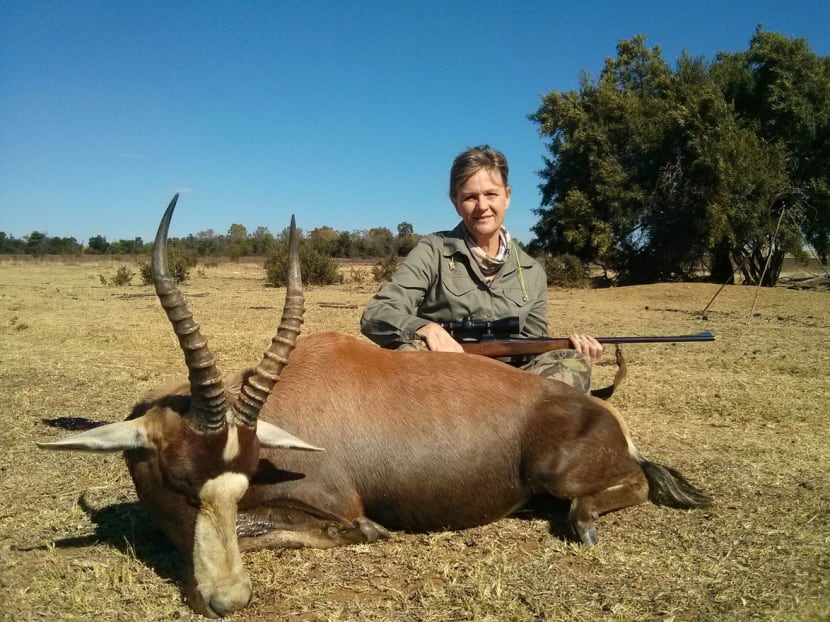South Africa hunters say best way to save wildlife is to kill it
JOHANNESBURG — A 140-pound (64kg) blesbok, a South African antelope, grazes on the country’s grassy plains under a clear blue winter sky.

Professional Hunters' Association of South Africa chief executive officer Adri Kitshoff poses with her rifle after hunting a blesbok. Photo: Bloomberg
JOHANNESBURG — A 140-pound (64kg) blesbok, a South African antelope, grazes on the country’s grassy plains under a clear blue winter sky.
As his 30-strong herd drifts away to a shadier area, he’s unaware that he’s now alone, and in the rifle sights of 57-year-old Adri Kitshoff. A shot cracks and the blesbok, who’s 110m away, collapses to the ground as a bullet enters his neck.
“That’s my shot,” Ms Kitshoff says, smiling as she turns from her rifle to journalists huddled behind her. “It went down immediately.”
The kill, watched by Bloomberg News, is an attempt by South African hunters to improve the industry’s reputation after criticism from animal-rights groups led to bans by governments and airlines on transporting carcasses, or trophies such as horns and mounted stuffed heads. Hunting has helped increase animal numbers in the country to the most since the 19th century, they say.
Ms Kitshoff, a mother of four with four grandchildren, is chief executive officer of the Professional Hunters’ Association of South Africa and shot the blesbok at Iwamanzi Nature Reserve in the North West province. She took the meat home the following day to eat.
ONE SHOT
“I’m glad it was a one-shot kill,” she said, her hands shaking with adrenaline as she walked toward the carcass. “That is your main aim, to put it down with one shot. I don’t have words to describe exactly how I feel now except I’m very humbled.”
South Africa has been criticised by animal rights groups for allowing its hunting industry, worth 6.2 billion rand (S$681 million) a year, to legally kill animals such as lions, elephants, rhinos and leopards. Most foreign hunters are from the US and can pay as much as US$300,000 (S$400,536) to shoot rare species such as black rhinos.
Practises such as so-called canned hunting, where lions are bred and then shot in relatively small areas, and selectively breeding animals for bigger horns and unusual coat colours have hurt the industry’s reputation further.
“Hunting in South Africa ran out of control a long time ago,” said Ms Ainsley Hay, a spokeswoman for the country’s National Society for the Prevention of Cruelty to Animals. “These animals are farmed for the hunting industry. How is that conservation?”
AIRLINE BAN
The chorus of criticism from animal-rights groups is gaining traction. South African Airways and Emirates banned customers from transporting lion, elephant, rhino and tiger carcasses this year while Australia outlawed importing lion body parts.
Yet Ms Kitshoff and Phasa, the hunting organisation, paint a different picture. Far from destroying wildlife, the money generated by hunting protects and rehabilitates natural habitats in Africa, increasing wildlife numbers, Ms Kitshoff said.
South Africa’s now has 24 million large mammals, up from fewer than 600,000 in the early 1960s, according to Dr Wouter van Hoven, an emeritus professor at the University of Pretoria. Animal numbers in Kenya, which focuses on eco-tourism activities such as game-viewing, have plunged 80 per cent since it banned hunting in 1977, according to Dr Mike Norton-Griffiths, a US zoologist.
Purely looking at numbers is misleading because “most of the animals we have now are not truly in the wild”, Ms Hay said. “They’re managed populations in contained areas.”
CARE INCENTIVE
In South Africa, unlike the rest of the continent, individuals can own, hunt and farm wildlife. As animals are profitable, people are incentivised to look after them and their habitats, Phasa President Hermann Meyeridricks said.
“Without sustainable utilisation of wildlife, of which hunting is a part, we won’t have wildlife in Africa,” he said. “In every country with a strong and growing wildlife population, there’s hunting.”
In Kenya, without such ownership rights, wild animals are pests that destroy crops and eat livestock so they are killed or poached, Mr Meyeridricks said.
Iwamanzi, where the hunt took place, is a case in point. A former overgrazed cattle farm with almost no wild animals, it was turned into a hunting reserve by Stan and Jacqueline Burger in 2005. It now has about 1,000 native animals including rhinos and giraffes as well a springbok and kudu antelopes roaming 3,700 hectares (37 sq km).
‘DIFFICULT ARGUMENT’
Mr Meyeridricks admits killing to conserve is a “difficult argument to make” when people focus on the welfare of an individual animal. The “greater good” is achieved by using hunting revenue to protect and grow wildlife numbers, he said.
The hunted blesbok was chosen because it was an old male beyond breeding age with two seasons left to live at most, according to Mr Tavi Fragoso, the professional hunter who guided Ms Kitshoff around the reserve.
The male met his end after almost four hours of stalking antelopes including impalas, kudus, red hartebeest, and wildebeest, also known as gnus. Earlier, Mr Fragoso instructed her not to shoot a young male impala and a breeding female kudu. She missed a shot at another impala ram.
“Knowing how the conservation model in South Africa works, I know I have contributed to conservation,” she said as she stood over the blesbok carcass. BLOOMBERG






